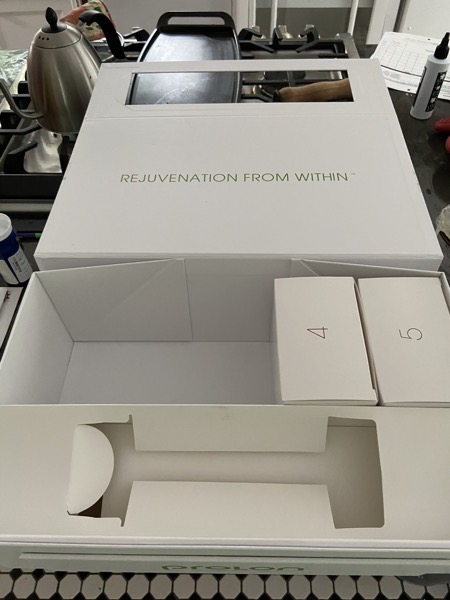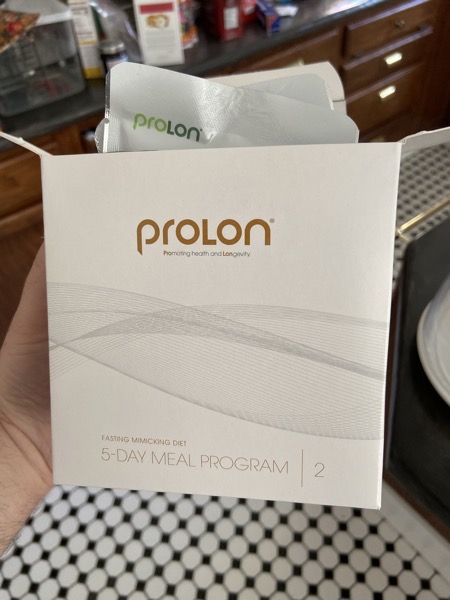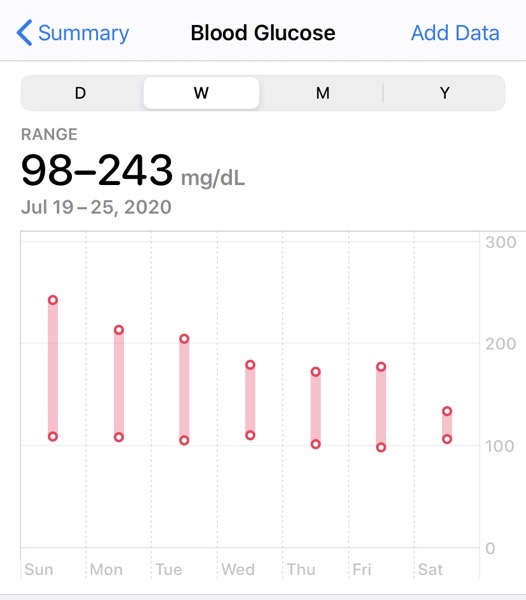Fasting is a fantastic way to treat type 2 diabetes. With no food to digest, your insulin levels will drop, and you’ll burn through fat in your liver and the rest of your body. And if you fast for multiple days your body will see additional benefits, such as autophagy kicking in and recycling old cells.
But fasting can be challenging! The ritual of multiple daily meals is deeply embedded into our lives. And, of course, the actual hunger is is kind of annoying to deal with (though it isn’t as bad as you might imagine).
I’ve experimented with an alternative called a fasting mimicking diet (hereafter referred to as an FMD). L-Nutra sells these as a kit under the Prolon brand and that’s what I’ve been using so far. The biggest drawback is that it’s fairly expensive at $250 (and that’s doubly disappointing when you factor in what a low calorie diet this is supposed to be!).
This isn’t quackery, either (despite an endorsement from Gwyneth Paltrow). It’s backed by decades of research on longevity performed by Dr. Valter Longo and his team. He devised this FMD protocol for cancer patients about to undergo chemo to give them better results but his research has shown that periodically going through an FMD will improve longevity and other important health markers, and the positive effects of the FMD continue even after you resume your normal diet.
Is the FMD easy to do? I don’t want to blow smoke up your ass. It’s not a walk in the park, but I’ve also done a 5 day water fast before, and the FMD is way easier to do, and it’s easier to incorporate into your daily life.
The kit comes in a box roughly the size of a shoe box:

(imagine the first three boxes are in there too)
When you look at it, you think “hey, this isn’t so bad.”Of course, then when you grab one of the boxes and remind yourself that this is all you’re eating today, it’s a little more daunting.

The food consists of powdered soups, kale crackers, olives, and snack bars. They also include some supplements, some teas, and for days 2–5, a glycerin-based energy drink.
This is how you can expect your week to go:
- Day 1: “Hey, this isn’t so bad! I get 2 of these nut and honey bars, two soups, a package of kale crackers, a chocolate bar type thing, and some olives. It’s actually pretty filling!
- Day 2: “Hey, wait a minute, this is less food than yesterday. What happened to my kale crackers and my second nut bar?
- Day 3: “Okay, we got the kale crackers back but what the hell happened to my olives?”
- Day 4: “Oooh, I’m almost done! Good thing, too; this is starting to get a little bit repetitive.”
- Day 5: “Well I’ll be damned, I did it!”
I made slight modifications. I largely didn’t bother with the glycerin drink on days 2–5; It struck me as empty calories (it’s basically water sweetened with glycerin with flavor added). To compensate for the calories the drink would have had, I augmented some of the meals with celery and ate some extra olives (I’ve kind of developed a taste for them!). One afternoon I had some seaweed snacks, and on the final day I augmented the final dinner with some slices of heirloom tomato. I was careful to not go over my overall calorie intake, and I have no regrets about any of these modifications. Especially the heirloom tomato; is there anything better than a nice ripe heirloom tomato?
Being a diabetic, I was skeptical about how healthy this FMD would actually be given that almost half the calories are from carbs. And while that’s a high percentage, when you’re eating <800 calories a day, the carbs aren’t really enough to do much to you (even when some of the soups use rice or potato flour as their first ingredient, both foods considered to have a high GI). And after a couple of days, you see a precipitous drop in blood sugars.
The morning I started my most recent FMD my glucose at 9am was 139. The morning after day 5, it was 119. More importantly, my ranges of blood sugars changed dramatically. On Day 1 of the FMD, they ranged from 109–243. The day after I finished the FMD, they ranged from 98–177. Today so far (2 days after the FMD ended) they’re ranging from 106–133.

That’s pretty damn good. And during the FMD I wasn’t even taking any diabetes medicine (I’m taking them again now, and that probably explains why my levels today look even lower)
When I first did an FMD I was incredibly skeptical of how well it would work compared to fasting; your caloric intake is almost half carbohydrates, after all, and the primary ingredient in some of these soups is potato flour and rice flour, which struck me as not particularly healthy. But keep in mind that while the percentage of carbs is high, the absolute carb count is very low. And lo and behold, my blood sugar numbers started looking quite good after a couple days into the FMD, and importantly, even after you’re done with the FMD, your insulin response is improved and blood sugar numbers stay quite good.
Also, I lost at least 5 pounds during the FMD (I say “at least” because I was afraid to weigh myself at the beginning, so my baseline is from a day between my last FMD and the morning after I finished this FMD).
My plan is to start doing an FMD every couple of weeks. For my next one I’m going to use foods I make myself, just to save money and offer myself a somewhat improved variety of foods. I feel super optimistic about this approach, too; each FMD is not a huge commitment, and I just have to spend the bulk of my willpower budget in short five-day increments.
Leave a Reply